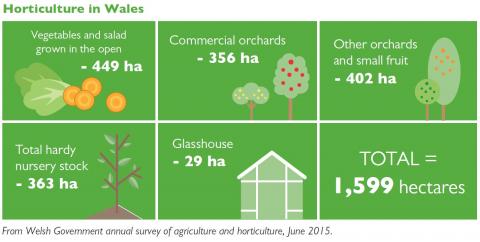Wales has the fundamentals to develop a thriving horticulture industry, if it can meet the challenges of adding value to locally grown produce.
Despite having many natural attributes which favor the sector, just 0.08% of all the agricultural land in Wales is currently used for horticulture.
Gareth Harrison, Arable and Horticulture coordinator for Farming Connect believes that “Wales has got most of the basic ingredients for developing its horticulture sector – a favourable climate, fertile soils and demand from nearby heavily populated centres. The challenge is to develop the skillsets required to grow commercially, knowing how to adapt production systems to cultivate crops profitably in Wales and being able to add value to better meet the demand of the market.”
According to the annual Welsh Agricultural Statistics publication, the amount of land used for horticultural activities (excluding potato cultivation) has increased over the last five years, from 1301ha in 2010 to 1599ha in 2015. The amount of land used for vegetable production accounted for part of this growth, up from 394ha in 2010 to 449ha in 2015. However, production figures can and tend to fluctuate considerably from year to year.
Over the same period, the amount of land used for orchards and small fruits has increased by 16% to 734ha in Wales. Orchards and small fruits account for a significantly higher proportion of the horticulture land use in Wales compared to the rest of the UK – 21% on a UK level compared to 48% in Wales.
Interestingly, the area under glass or plastic cover has steadily fallen from 38ha to 29ha, despite an additional 131ha of new glass cover been installed in the UK between 2013 and 2015. The land area used for producing potatoes in Wales has gradually climbed from 2056ha in 2010 to 2775ha in 2014, a rise set against the backdrop of falling potato cropping area on a UK basis over the same period.
Latest DEFRA published figures shows the important contribution the UK’s horticultural industry makes to the economy. In 2014, UK produced vegetables achieved a farm gate value of approximately £1.20billion, UK fruit was worth £620million and ornamentals were worth a further £1.17billion.
Like most farm produce, the value of horticultural crops can vary significantly from season to season due to market forces. In 2014, the value of vegetable crops fell 8.5% compared to 2013, despite an increase of 5.6% in production. The UK’s fruit crop however increased in value by 7.5% from 2013 to 2014 due to strong demand, good yields and a longer growing season. Different parts of the horticulture sector can perform very differently at the same time, which means growers need to keep a careful eye on the market for early signs of threats or opportunities.
The value of protected vegetables in the UK rose 7.8% in 2014, to £348million, and is up 40% since 2005. Factors such as warm weather and increased demand for salad items have been cited as key reasons for the growth in value.
2014 was a record year for UK strawberry (104,000t) and raspberry (17,800t) production, and prices remained relatively strong for both crops.
Gareth says the demand for local food will fuel growth in the horticulture sector in Wales.
“Over the years studies have shown an increasing demand for products grown locally, so the challenge is to try to find a profitable way of supplying the food trade - restaurants, hotels, shops and cafes with produce cultivated in Wales,” he adds. “Potential growers need to focus on crops that are high in value and relatively simple to cultivate with short, straightforward production cycles. Good examples are leafy salads and soft fruit, especially if a proportion can be harvested out of season, to get a better price.”
Across Wales, small specialist growers have formed direct supply partnerships with restaurants or shops, with each partner understanding the other’s needs. Other growers may choose to specialise with niche products such as chillies or garlic, and develop on-line sales. Many of Wales’ fresh produce distributors are also actively looking to improve their local offering and can provide efficient route to market for some growers.
Further innovative examples of marketing fresh produce include honesty boxes at the farm gate and vegetable box schemes. A Scottish vegetable grower recently pioneered a system for selling his produce, mostly selections of root crops, via a vending machine located in a busy shopping centre.
Horticulture is a very innovative and technological industry and in order to develop the sector in Wales, further investment and improved co-ordination will be needed.
“There are pockets in Wales with quite a bit of activity in the sector, but they’re still small and scattered - we need to learn more from those people who are successful to see what can be done,” says Mr Harrison. “We also need to take lessons from other countries who seem to be way ahead of us.”
The Netherlands leads the world in horticulture innovation. Much of the current effort in the Netherlands is focused on improving the industry’s sustainability, with major advances in biological crop protection, energy saving, utilising renewable sources such as solar and geothermal, and developing closed water system in glasshouses.
Back in Wales, there are a number of opportunities for new and existing growers. Based on market intelligence, current opportunities in horticulture include strawberry and raspberry cropping, kale, asparagus, leafy salads, rhubarb, fresh herbs and specialist ornamentals.
As with all new enterprises, detailed market research is required to identify a profitable route to market and to consider what value could be added. Time spent on developing a strong brand should pay dividend by ensuring the customer understands what makes your produce different and special.

